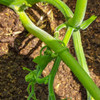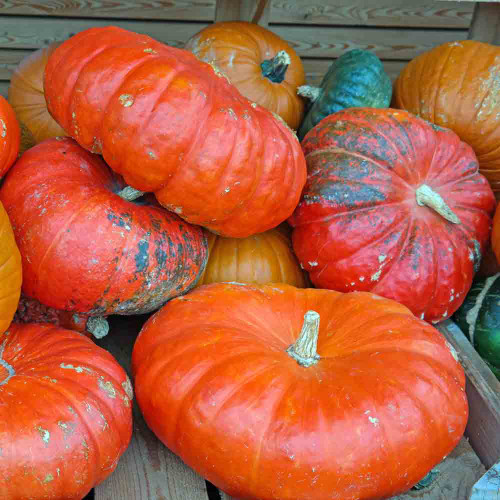Seminole Pumpkin Seeds - (Cucurbita moschata)
- SKU:
- V1560
- Seed Count:
- Approx 12 seeds per pack
- Days to Maturity:
- 120 days
- Size:
- 1-2 lbs
- Days to Germination:
- 5-10 days @ 70F
- Plant Spacing:
- 4'
- Soil Requirements:
- Warm, well-drained
- Light Preference:
- 6-8 hours of direct sunlight
- Type:
- Winter
- Status:
- Heirloom, Non-Hybrid, Non-GMO seeds
Description
Seminole Pumpkin - Hardy, Delicious, and Prolific
This ancient landrace pumpkin from the Everglades has been loved and grown for centuries, beginning with the Seminole tribes and later by gardeners across Florida. It shrugs off heat, humidity, and most diseases and insects that drop other pumpkins, yet it is consistently the last producing pumpkin in the northern gardens of Cape Cod.
The term landrace describes a domesticated, locally adapted, often traditional variety of a species of plant that has developed over time, through adaptation to its natural and cultural environment of agriculture and pastoralism, and due to isolation from other populations of the species. This perfectly describes the origin of the Seminole pumpkin.
This wild pumpkin was traditionally grown by the Native American tribes Calusa, Creek, and Miccosukee peoples, who became known as the Seminole tribes. They named a region on the gulf of the west coast of Florida “Chassa Howitska” which means “pumpkin hanging place”, referring to how the vines grew up the trees with the pumpkins hanging from bare tree limbs.
Wild Seminole pumpkins are now rare, but the Chassahowitzka River bears the name as a reminder of the wild pumpkins that once grew on the banks.
Our seedstock came from Janisse Ray in southeastern Georgia. She is an acclaimed nature writer and the author of The Seed Underground: A Growing Revolution to Save Food, among several others. Her writing reflects her lifetime spent in the trackless wilds and woods of northern Florida and southern Georgia. She has grown these and saved seeds for a number of years.
Intro
This beloved pumpkin of south Florida is specially celebrated in the Florida gardening community for its unparalleled heat tolerance.
Its silver-haired leaves create a shiny silvery reflectance under the intense Florida sun that almost completely keeps insect pests from attacking the plants. This pumpkin is well-adapted to Southern climates yet is tolerant to both dry and rainy extremes.
In addition to being virtually immune to pests and diseases, this beloved heirloom is legendary for its almost absurd production. It is quite common to hear gardeners commenting that they harvested over 20 pumpkins from 5 vines or 12 pumpkins from 2 vines. One gardener stated they only planted one vine, and harvested 9 pumpkins while it continued to flower and produce.
Thanks to their tough, thick skin, Seminole pumpkins can be stored whole in a dry location with good ventilation for up to a year.
Details
Seminole pumpkins (Cucurbita moschata) are a large vining variety, traditionally planted at the base of a tree where the vines wrapped around the limbs and the pumpkins hung down. They will grow on the ground but will take up significant space, so a tall or wide trellis or tall fence is ideal.
The leaves are covered with soft silvery hairs that keep insects away and can be from 6” to a foot long. The flowers are funnel-shaped, crinkly, bright to deep yellow, with five lobes, and are 3-4” wide. The fruit has many forms, but the preferred one is squat, round, and slightly ridged with a slight teardrop shape. When mature the shell is yellow-orange with deep orange flesh that is dry and firm and flat, elliptic, white seeds in the central cavity. The best flavor comes from fruit between 1 1/2 to 2 lbs.
Seminole plants are resistant to downy mildew, most diseases, and pests like the destructive and difficult-to-control squash vine borer which kills most squash. Squash bugs will still sometimes feed on the pumpkin stems, but they don’t seem to slow it down.
They require little maintenance from the gardener aside from consistent moisture and reasonably fertile soil. Pumpkin flowers need insects to pollinate them, so plant pollinator-attracting flower mixes nearby.
History
The Seminole pumpkin has long been intertwined with the indigenous groups of Florida - the Calusa, Tequesta, Tocobaga, Jobe/Jaegas, Ayes, and Apalachee, who would eventually become collectively known as the Seminoles, a name meaning “wild people.”
Pumpkins and squash are native to North America.
In 1528 Panfilo de Narvaez, a Spanish soldier and explorer saw Seminole pumpkins growing in dead trees near present-day Tallahassee. Another early description comes from the 1575 memoir of Spanish shipwreck survivor Hernando de Escalante Fontaneda when he was a captive of the Colusa tribe in north Florida for 17 years.
American naturalist William Bertram noted the Seminole pumpkins in his 1774 journal which “searched the Floridas for rare and useful productions of nature”. He wrote, “The trees along riverbanks are adorned with garlands of various species of morning glory, moonflower and squash and gourds which ran and spread over bushes and trees 20 or 30 yards high”.
Uses
Seminole pumpkin is a multi-use plant - the abundant male flowers are excellent dipped in batter and fried as fritters or stuffed and cooked, while the very young, tender fruits are delicious with a nutty flavor when eaten like summer squash. Mature pumpkins were sliced, sun-dried, and stored for winter use by the Seminole tribes.
There will be approximately 8-10 male flowers for each female flower, giving lots to work with in stuffing and frying.
Seminole pumpkin bread is one of the traditional recipes so highly regarded that it is still featured during tribal ceremonies and at tribal-owned restaurants. The bread is closer to a fritter or empanada than yeast bread.
The fully ripe pumpkin flavor is as sweet or even sweeter than butternut squash and the flesh is firm and dry, not pithy as some pumpkins can be.
Janisse loves them because they are easy to grow, prolific, and delicious, and she finds they can easily store for over a year without losing any flavor.
Travis grows these for us in northern Georgia, his first experience with these unique pumpkins. When we asked for his thoughts on them, he commented that he and his family love them so much that they won’t grow any other pumpkins anymore. He said they make the best-tasting pumpkin pie he’s ever had, and friends who do not really like pumpkin pie asked him for the recipe.
Growing Tip
Direct sow 2 seeds per hill spaced about 4 feet apart in warm soil that gets at least 6-8 hours of direct sunlight. The vines can grow up to 25 feet, so give them room on a fence or trellis. They make an excellent shade or windbreak when grown on tall cattle panels or other sturdy fencing.
Blossoms are usually bee-pollinated, so planting pollinator flowers will bring in more bees and give you a better crop.
Expect to see 8-10 male flowers for each female flower. Male flowers appear first, followed by female flowers a few weeks later, so plan on feasting on squash blossoms! If the plant becomes water-stressed it stops producing female blossoms, so keep the soil moisture consistent. It doesn’t need damp soil, but you should easily feel the soil moisture when digging 2” deep.
After producing, that portion of the vine will die back but the nodes will root, creating vigorous runners and keep growing, flowering and fruiting, yielding a continuous supply until the first good frost in the fall.
Harvest Tip
The pumpkins are mature and ready for harvesting when the color ripens to a sandy orange. Harvest by cutting the stem about 4” from the pumpkin - don’t twist or tear the stem as this allows rot and disease into the fruit. Don’t use the stem as a handle, carry it by supporting the pumpkin from the bottom. Once harvested, store them in a cool, dry place.
Learn More
- Grow Great Pumpkins from Seed to Harvest
- Roasted Pumpkin Puree
- 3 Great Heirloom Pumpkin Recipes
- Pumpkin-Orange Cheesecake
- Thanksgiving Turkey and Pumpkin Soup
From the soil to the seed to the food you eat - we'll help you grow your best garden!
2 Reviews
-
Update: 100% Germination
Update to my previous review. All seeds I bought from Terroir Seeds germinated. I planted Seminole pumpkins and jarrahdale. Thanks! Highly recommend.
-
Packaging was nice with clear instructions
I bought two packs of the Seminole pumpkin seeds. The seeds looked nice and the instructions on the package were great since I am new into gardening. I’m germinating a few seeds now since I am in a Zone 12b (Hawaii) I believe I will be able to plant these year round. I can’t wait to try them. I went with terroir seeds because the pictures of their Seminole pumpkins looked tasty with lots of flesh. I hope that’s what I get. Thank you for the quick shipping also!





















